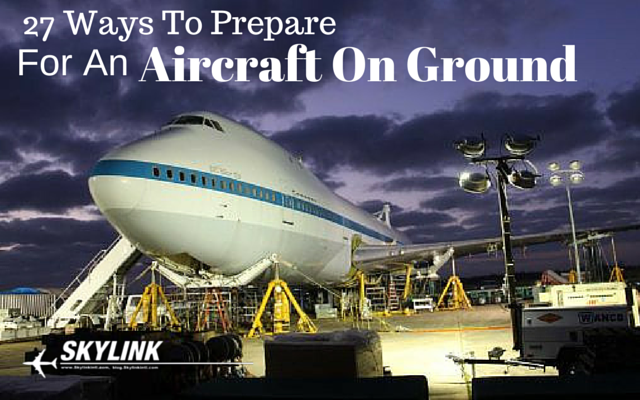You’ve heard it from hundreds of companies, “we have a 24/7/365 AOG service.”

It’s like throwing rocks into an ocean. Some rocks sink faster than others, and the same is true with the hundreds of 24/7 AOG service claims.
Some use the term for marketing purposes, while others have an exclusive AOG service for stock items (that’s the goal right?).
95% of all AOG services are reactive solutions. A true airline AOG service isn’t just about getting you a single aircraft component in the shortest amount of time. It’s about much more than that. A sound AOG service focuses it's attention on preventative strategies. The true magic happens when partners (airline + component distributor) sit down and discuss proactive solutions.
Aircraft maintenance will always have it’s bouts of reactive issues, but it’s beating these issues down on the front end…before they become an AOG problem.
It’s about stopping the AOGs before they ever become an actual AOG.
Create an AOG list
Some airlines have reoccurring AOGs for the same product line, which is where safety stock plays an integral role. Others experience component failures along a statistical spread based on mean times between failures (MTBF) and mean time between removals (MTBR).
Some airlines experience AOGs for just rotables, while others experience AOGs for rotables, consumables, and expendables.
So what does this mean for you?
You’ve worked on your MEL no-go list, but every airline operation is unique. From a fleet flying around the sandy Saharan desert, to fleets flying through the blistering cold of the Alaskan frontier, every operation is different.
In order to combat your onslaught of AOGs without having to invest millions in safety stock and life limited consumables, first create your high usage AOG list.
- Rotables: Create a list of your high removal rate, no-go rotables. Of course don’t just leave it at this. If you have certain product lines that have reoccurring unplanned removals, add them to this list. This list is your rotable AOG strategy playbook. You add and remove components to this list as needed. This is your baseline analytical forecasts. They get much more complicated than this but this is a start.
- Expendable: The next tier of AOG prevention is building your high usage expendable list. When you know what expendables are consumed most frequently or are needed most often, prepare your list.
- Consumables: The same is true for your consumable list. Create a high usage consumable list.
Do you see where I’m going with this?
Now that you’ve created a list of no-go and high usage items, you move on to the next step…
Having rotables, expendables & consumables at the right time, in the right place
Minimizing your AOG is having the right part, at the right time, in the right place…without drastically increasing you’re operating expenditure. Having inventory suck away your available cash (more on that below) is a disaster waiting to happen.
The next step is to logically think of your logistical and procurement plan. Buying material on an AOG basis is making you reactive which is unproductive. You have to plan solutions on the front end.
Here are some ideas that can be applied to the 3 lists you created in the previous section:
- Invest heavy amounts of cash for keeping your safety stock replenished (not my preferred recommendation)
- Use a pooling or PBH program so you pay for performance and limit your capital risk on inventory.
- Work with your supplier to replenish the lists you created every X (x days, x months, x quarters, etc) or based on a consumption forecast you worked on together.
- Have your supplier stock high usage material near your facility for easy access. Pay for material only as you consume it.
- Send your component partner the 3 lists you created and have them keep stock on hand.
- Have your partner create a logistical strategy to your facility. If transit time is an issue, have them propose a solution.
- Consolidate monthly reoccurring purchases to your facility, reducing expenditure and increasing material delivery.
- Have your component partner stock high-usage, high AOG probability parts at your facility. Pay for access, pay for usage.
As you can see, the strategies are limitless and they surround your need to reduce AOGs and inventory expenditure. Your component partner is an expert (Skylink being one these of course) who will help you create these strategies.
Reducing the financial burden of preventative AOG strategies
Forget the statistics of spending $1.5M per aircraft in inventory. You make money in the air. Inventory is on the ground. Your goal is to be efficient not only with your fleet but also with your cash.
There are component distributors who specialize in inventory, that’s what they do. For you not to take advantage of this puts you at a financial disadvantage. Take JetBlue for example. They outsource everything, and are a profitable airline because of it. They’ve reduced their overhead and focused on core, money-making activities.
The same is true for you.
Come up with your 3 lists and work with your trusted partner to devise a strategy where they support your every rotable, expendable and consumable need.
It can be much easier than having to constantly react to AOGs. Be proactive and beat your AOGs on the front end.
P.S. We’ve come up with airline support strategies for all of our airline clients. Are you having an increase in AOGs? Do you want to be more proactive in your component support? Do you want to spend less money on inventory and AOG processing? Do you want more cash to support your operation? If yes, fill out the below form and let’s get started TODAY.








